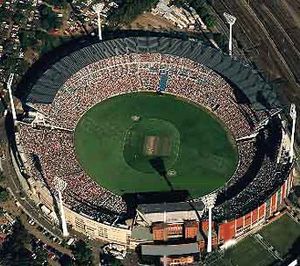Seating capacity facts for kids


Seating capacity is the total number of people who can sit in a specific place. This limit can be set by how much space is available. It can also be decided by safety rules or laws that say how many people are allowed to be there at one time.
Seating capacity is important for many different things. It can tell us how many people can fit into a vehicle, like a car or an airplane. It also tells us how many fans can watch a game in a stadium. For example, the Indianapolis Motor Speedway is a huge sports building. It can hold over 257,000 people in its permanent seats. If extra seats are added on the field, it can even fit about 400,000 people!
Contents
What is Seating Capacity?
Seating capacity means the maximum number of people who can sit down in a certain area. Think of it like a puzzle. Each person needs a certain amount of space to sit comfortably and safely. This space can be a seat in a movie theater, a spot on a bus, or a chair at a concert.
The capacity is not just about fitting as many people as possible. It also considers safety. Building codes and local laws often set limits. These rules make sure there are enough exits and space for everyone in case of an emergency.
Why is Seating Capacity Important?
Knowing the seating capacity helps with planning. For example, event organizers need to know how many tickets they can sell for a concert. Bus companies need to know how many passengers their buses can carry.
It also helps with safety. If too many people are in one place, it can become dangerous. There might not be enough room for people to move around. It could also make it hard to leave quickly if needed.
Seating in Different Places
Seating capacity applies to many different places and vehicles.
Vehicles
- Cars: Most cars can seat between 2 and 7 people. Larger vehicles like vans can hold more.
- Buses: A typical city bus might seat 30 to 50 people. School buses often have similar capacities.
- Airplanes: Small planes might seat only a few people. Large passenger jets can carry hundreds. Some jumbo jets can seat over 500 passengers!
- Trains: Passenger trains can have many cars. Each car has seats for dozens of people. A whole train can carry thousands.
Sports Stadiums and Arenas
Sports venues are known for their large seating capacities. They are designed to hold many fans who come to watch games or events.
- Football Stadiums: Many big football stadiums can seat over 60,000 people. Some of the largest in the world hold over 100,000.
- Basketball Arenas: These are usually smaller than stadiums. They often seat between 15,000 and 20,000 fans.
- Baseball Parks: Major League Baseball parks typically seat between 35,000 and 50,000 people.
- Horse Racing Tracks: Some tracks, like the Churchill Downs in the USA, can hold over 150,000 people. This includes both seated and standing areas.
Largest Venues by Seating Capacity
Some places are famous for being able to hold a huge number of people.
- Indianapolis Motor Speedway: Located in the United States, this famous race track has the largest permanent seating capacity in the world. It can seat over 257,000 people. For big events like the Indianapolis 500, temporary seats are added. This brings the total capacity to around 400,000 people!
- Rungrado 1st of May Stadium: This stadium is in North Korea. It is one of the largest stadiums in the world by capacity. It can hold about 114,000 people. It is used for football games and other large events.
- Michigan Stadium: This is a college football stadium in the United States. It can seat over 107,000 fans. It is one of the biggest stadiums in the Western Hemisphere.
- Melbourne Cricket Ground (MCG): Located in Australia, the MCG is a very famous stadium. It can hold about 100,000 people. It hosts cricket, Australian Rules Football, and other major events.
Images for kids
-
The Indianapolis Motor Speedway has the largest seating capacity of any venue in the world.
-
An aerial view of the Melbourne Cricket Ground during the 2018 AFL Grand Final, packed with 100,000 people
See also
 In Spanish: Aforo (recinto) para niños
In Spanish: Aforo (recinto) para niños




